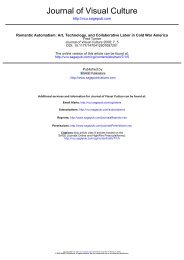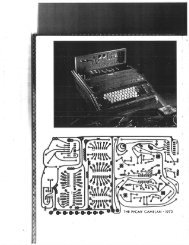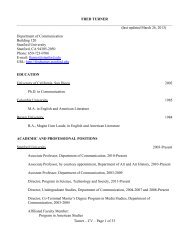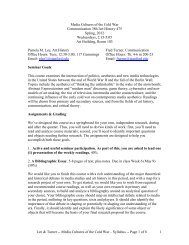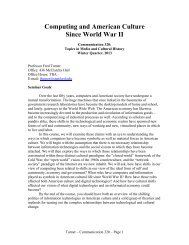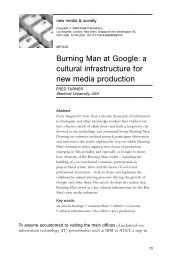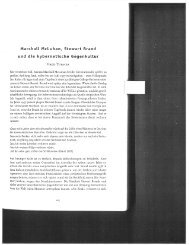The Family of Man and the Politics of Attention in ... - Public Culture
The Family of Man and the Politics of Attention in ... - Public Culture
The Family of Man and the Politics of Attention in ... - Public Culture
You also want an ePaper? Increase the reach of your titles
YUMPU automatically turns print PDFs into web optimized ePapers that Google loves.
<strong>Public</strong> <strong>Culture</strong><br />
When visitors arrived at <strong>the</strong> Museum <strong>of</strong> Modern Art <strong>in</strong> 1955, <strong>the</strong>y encountered<br />
an exhibition that drew extensively on <strong>the</strong> extended field <strong>of</strong> vision aes<strong>the</strong>tic <strong>and</strong><br />
<strong>the</strong> pro- democratic, gestaltist psychology <strong>of</strong> view<strong>in</strong>g that characterized Steichen’s<br />
earlier Road to Victory. As <strong>the</strong>y moved toward <strong>the</strong> stairs that would take <strong>the</strong>m to<br />
<strong>the</strong> second- floor view<strong>in</strong>g galleries, visitors received a pamphlet with a prologue<br />
by S<strong>and</strong>burg that set <strong>the</strong> <strong>in</strong>terpretive stage. “<strong>The</strong> first cry <strong>of</strong> a newborn baby <strong>in</strong><br />
Chicago or Zamboango, <strong>in</strong> Amsterdam or Rangoon, has <strong>the</strong> same pitch <strong>and</strong> key,”<br />
it announced, “each say<strong>in</strong>g, ‘I am! I have come through! I belong! I am a member<br />
<strong>of</strong> <strong>the</strong> <strong>Family</strong>.’ ” Lest his audience miss <strong>the</strong> po<strong>in</strong>t, S<strong>and</strong>burg expla<strong>in</strong>ed that <strong>in</strong> <strong>the</strong><br />
exhibition, “you travel <strong>and</strong> see what <strong>the</strong> camera saw. . . . You might catch yourself<br />
say<strong>in</strong>g, ‘I’m not a stranger here.’ ” 35<br />
Pamphlet <strong>in</strong> h<strong>and</strong>, viewers <strong>the</strong>n passed <strong>in</strong>to an entryway <strong>and</strong> under an arch<br />
covered with images <strong>of</strong> a huge crowd seen from <strong>the</strong> air. Directly <strong>in</strong> front <strong>of</strong> <strong>the</strong>m,<br />
<strong>the</strong>y saw a river. To walk under <strong>the</strong> arch <strong>and</strong> <strong>in</strong>to <strong>the</strong> exhibition space was to<br />
step <strong>in</strong>to <strong>the</strong> river <strong>of</strong> humanity, flow<strong>in</strong>g through time. But it was very def<strong>in</strong>itely<br />
not to become part <strong>of</strong> an anonymous mass. On <strong>the</strong> contrary, when <strong>the</strong>y left <strong>the</strong><br />
foyer, visitors largely left images <strong>of</strong> crowds beh<strong>in</strong>d. As <strong>the</strong>y entered <strong>the</strong> exhibition<br />
proper, visitors faced a Lucite wall hung with images <strong>of</strong> <strong>in</strong>dividuals <strong>and</strong><br />
couples — sitt<strong>in</strong>g under a tree, chatt<strong>in</strong>g on a street corner, kiss<strong>in</strong>g, work<strong>in</strong>g — as<br />
well as a wedd<strong>in</strong>g procession. By implication, <strong>the</strong> entryway rem<strong>in</strong>ded visitors<br />
that much as America had defeated <strong>the</strong> fascists <strong>of</strong> World War II, <strong>the</strong> Americans<br />
<strong>of</strong> 1955 could defeat <strong>the</strong> new authoritarian forces <strong>of</strong> massification at home <strong>and</strong><br />
abroad <strong>and</strong> enter a peaceful, global society <strong>of</strong> <strong>in</strong>dividuals. Moreover, as S<strong>and</strong>burg<br />
had told <strong>the</strong>m, <strong>the</strong>y would not be strangers; on <strong>the</strong> contrary, <strong>in</strong> all <strong>of</strong> <strong>the</strong> racial <strong>and</strong><br />
cultural differences <strong>the</strong>y would see, <strong>the</strong>y would recognize <strong>the</strong>mselves.<br />
It would be easy to characterize this logic as emblematic <strong>of</strong> a sort <strong>of</strong> national<br />
narcissism <strong>in</strong> Cold War America <strong>and</strong> even perhaps <strong>of</strong> <strong>the</strong> imperial desire to remake<br />
<strong>the</strong> globe <strong>in</strong> America’s image. While such thoughts may <strong>in</strong>deed have hovered <strong>in</strong><br />
<strong>the</strong> m<strong>in</strong>ds <strong>of</strong> <strong>of</strong>ficials at <strong>the</strong> State Department, to focus on <strong>the</strong>m exclusively is to<br />
miss <strong>the</strong> exhibition’s more rebellious, ant<strong>in</strong>ationalist elements. Consider <strong>the</strong> layout<br />
<strong>of</strong> <strong>the</strong> exhibition. Rudolph, its architect, has described his design as “tell<strong>in</strong>g a<br />
story.” 36 Over <strong>the</strong> years, critics have agreed: many have characterized <strong>the</strong> show as<br />
draw<strong>in</strong>g viewers down a <strong>the</strong>matic tunnel. At <strong>the</strong> entrance to <strong>the</strong> exhibition, <strong>the</strong>y<br />
35. Carl S<strong>and</strong>burg, prologue to Edward Steichen <strong>and</strong> Museum <strong>of</strong> Modern Art (New York), <strong>The</strong><br />
<strong>Family</strong> <strong>of</strong> <strong>Man</strong>: <strong>The</strong> Greatest Photographic Exhibition <strong>of</strong> All Time — 503 Pictures from 68 Countries<br />
(New York: Museum <strong>of</strong> Modern Art <strong>and</strong> Maco Magaz<strong>in</strong>e Corp., 1955), 3.<br />
36. Paul Rudolph, <strong>in</strong>terview by Mary Anne Staniszewski, December 27, 1993, quoted Staniszewski,<br />
Power <strong>of</strong> Display, 240.<br />
76



